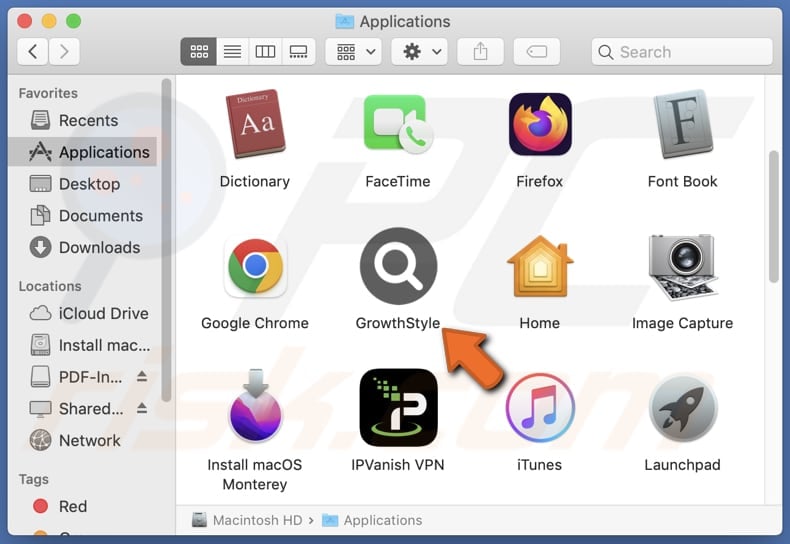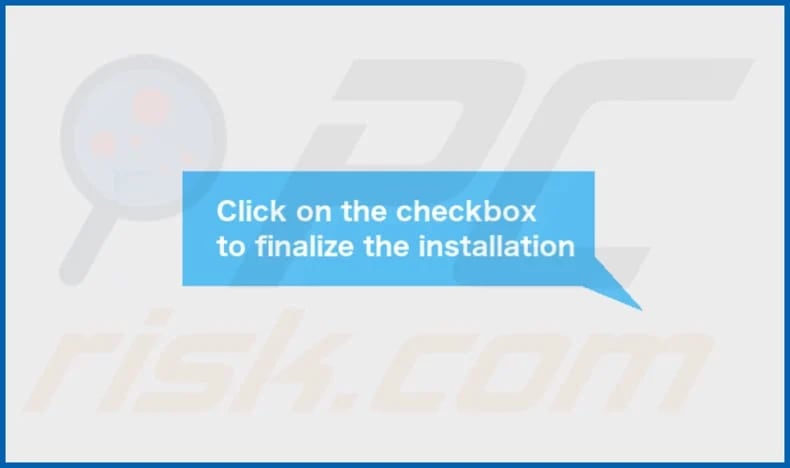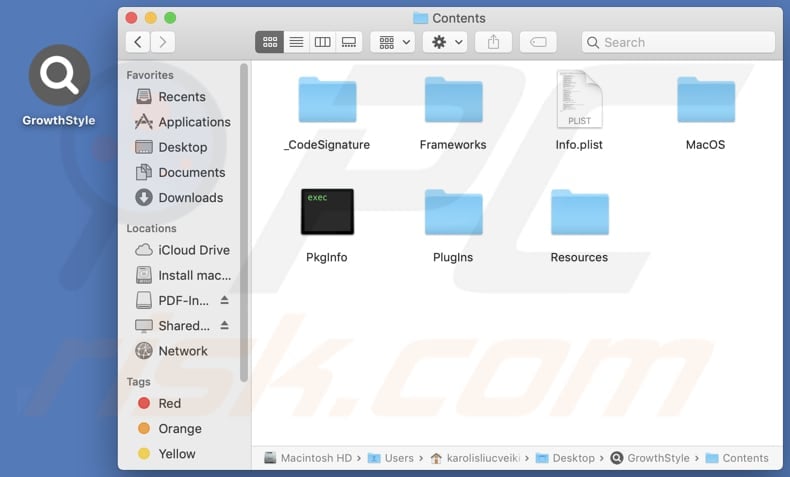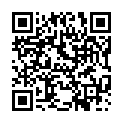How to remove GrowthStyle from your computer
![]() Written by Tomas Meskauskas on
Written by Tomas Meskauskas on
What kind of application is GrowthStyle?
When examining the GrowthStyle app, we noted that it bombards users with intrusive advertisements promoting questionable and potentially malicious websites. Thus, we classified GrowthStyle as adware. It is common for software of this type to be distributed using deceptive strategies and installed by users inadvertently.

GrowthStyle adware in detail
GrowthStyle may display various pop-ups, coupons, banners, and other ads intended to mislead users. Clicking these ads might lead users to fake lotteries, surveys, and similar scams designed to trick them into providing sensitive information or transferring money (e.g., paying fake fees). Also, these ads may promote shady apps.
Users may land on sites hosting other adware, browser hijackers, or even malicious software designed to encrypt files, extract information, mine cryptocurrency, or perform other malicious actions. Furthermore, users may encounter technical support scams designed to trick users into providing remote access to their computers, paying for fake services or products, or downloading malware.
Also, ads from GrowthStyle may be designed to trigger unwanted downloads and installations. Thus, it is strongly recommended to refrain from interacting with ads from apps like GrowthStyle, especially if these apps were downloaded from unreliable sources. In addition to displaying unreliable ads, adware can be designed to collect data.
While active, software like GrowthStyle may gather browsing data, email addresses, names, surnames, or other information. Sometimes, such apps can access credit card details, passwords, and more. Overall, installing adware on computers can lead to various negative consequences, including monetary loss and computer infections.
| Name | Ads by GrowthStyle |
| Threat Type | Adware, Mac malware, Mac virus |
| Detection Names | Avast (MacOS:Adload-AB [Trj]), Combo Cleaner (Gen:Variant.Adware.MAC.Adload.5), ESET-NOD32 (A Variant Of OSX/Adware.Synataeb.C), Kaspersky (Not-a-virus:HEUR:AdWare.OSX.Adload.g), Full List (VirusTotal) |
| Additional Information | This application belongs to Adload malware family. |
| Symptoms | Your Mac becomes slower than normal, you see unwanted pop-up ads, you are redirected to dubious websites. |
| Distribution methods | Deceptive pop-up ads, free software installers (bundling), torrent file downloads. |
| Damage | Internet browser tracking (potential privacy issues), display of unwanted ads, redirects to dubious websites, loss of private information. |
| Malware Removal (Mac) | To eliminate possible malware infections, scan your Mac with legitimate antivirus software. Our security researchers recommend using Combo Cleaner. |
Conclusion
In summary, apps like GrowthStyle pose risks to users by displaying misleading ads that can lead to scams and malicious websites. Users should exercise caution and avoid interacting with ads from such apps, as they can result in various negative consequences, including financial loss and compromised computer security.
More examples of adware-type apps like GrowthStyle are WebCoordinator, AgentUpdater, and SyncProgress.
How did GrowthStyle install on my computer?
Adware is often bundled with free or unreliable software and users agree to install it during software installation. Typically, installers containing adware provide "Advanced", "Custom", or similar options/settings that need to be changed to reject unwanted offers (e.g., adware).
Misleading advertisements and pop-ups can also be used to trick users into installing adware. For instance, these ads may promote useful tools that actually operate as adware. Additionally, unwanted installations can occur through downloads from P2P networks, unofficial pages, third-party app stores, etc.
How to avoid installation of unwanted applications?
Always use official websites or reputable app stores to download apps and files. Avoid downloading apps with no or bad reviews. Check the provided settings and options during installations, and deselect any unwanted additional apps. Do not trust ads and offers to install software updates (or similar offers) on dubious web pages.
Avoid accepting notifications from suspicious sites and regularly scan your computer for unwanted (including malicious) applications. Additionally, install reputable security software and make sure to keep it up to date. If your computer is already infected with GrowthStyle, we recommend running a scan with Combo Cleaner Antivirus for macOS to automatically eliminate this adware.
A message that appears after the installation of GrowthStyle adware:

GrowthStyle's installation folder:

Instant automatic Mac malware removal:
Manual threat removal might be a lengthy and complicated process that requires advanced IT skills. Combo Cleaner is a professional automatic malware removal tool that is recommended to get rid of Mac malware. Download it by clicking the button below:
▼ DOWNLOAD Combo Cleaner for Mac
By downloading any software listed on this website you agree to our Privacy Policy and Terms of Use. To use full-featured product, you have to purchase a license for Combo Cleaner. Limited seven days free trial available. Combo Cleaner is owned and operated by Rcs Lt, the parent company of PCRisk.com read more.
Quick menu:
- What is GrowthStyle?
- STEP 1. Remove GrowthStyle related files and folders from OSX.
- STEP 2. Remove GrowthStyle ads from Safari.
- STEP 3. Remove GrowthStyle adware from Google Chrome.
- STEP 4. Remove GrowthStyle ads from Mozilla Firefox.
Video showing how to remove GrowthStyle adware using Combo Cleaner:
GrowthStyle adware removal:
Remove GrowthStyle-related potentially unwanted applications from your "Applications" folder:

Click the Finder icon. In the Finder window, select "Applications". In the applications folder, look for "MPlayerX", "NicePlayer", or other suspicious applications and drag them to the Trash. After removing the potentially unwanted application(s) that cause online ads, scan your Mac for any remaining unwanted components.
Remove adware-related files and folders

Click the Finder icon, from the menu bar. Choose Go, and click Go to Folder...
 Check for adware generated files in the /Library/LaunchAgents/ folder:
Check for adware generated files in the /Library/LaunchAgents/ folder:

In the Go to Folder... bar, type: /Library/LaunchAgents/

In the "LaunchAgents" folder, look for any recently-added suspicious files and move them to the Trash. Examples of files generated by adware - "installmac.AppRemoval.plist", "myppes.download.plist", "mykotlerino.ltvbit.plist", "kuklorest.update.plist", etc. Adware commonly installs several files with the exact same string.
 Check for adware generated files in the ~/Library/Application Support/ folder:
Check for adware generated files in the ~/Library/Application Support/ folder:

In the Go to Folder... bar, type: ~/Library/Application Support/

In the "Application Support" folder, look for any recently-added suspicious folders. For example, "MplayerX" or "NicePlayer", and move these folders to the Trash.
 Check for adware generated files in the ~/Library/LaunchAgents/ folder:
Check for adware generated files in the ~/Library/LaunchAgents/ folder:

In the Go to Folder... bar, type: ~/Library/LaunchAgents/

In the "LaunchAgents" folder, look for any recently-added suspicious files and move them to the Trash. Examples of files generated by adware - "installmac.AppRemoval.plist", "myppes.download.plist", "mykotlerino.ltvbit.plist", "kuklorest.update.plist", etc. Adware commonly installs several files with the exact same string.
 Check for adware generated files in the /Library/LaunchDaemons/ folder:
Check for adware generated files in the /Library/LaunchDaemons/ folder:

In the "Go to Folder..." bar, type: /Library/LaunchDaemons/

In the "LaunchDaemons" folder, look for recently-added suspicious files. For example "com.aoudad.net-preferences.plist", "com.myppes.net-preferences.plist", "com.kuklorest.net-preferences.plist", "com.avickUpd.plist", etc., and move them to the Trash.
 Scan your Mac with Combo Cleaner:
Scan your Mac with Combo Cleaner:
If you have followed all the steps correctly, your Mac should be clean of infections. To ensure your system is not infected, run a scan with Combo Cleaner Antivirus. Download it HERE. After downloading the file, double click combocleaner.dmg installer. In the opened window, drag and drop the Combo Cleaner icon on top of the Applications icon. Now open your launchpad and click on the Combo Cleaner icon. Wait until Combo Cleaner updates its virus definition database and click the "Start Combo Scan" button.

Combo Cleaner will scan your Mac for malware infections. If the antivirus scan displays "no threats found" - this means that you can continue with the removal guide; otherwise, it's recommended to remove any found infections before continuing.

After removing files and folders generated by the adware, continue to remove rogue extensions from your Internet browsers.
Remove malicious extensions from Internet browsers
 Remove malicious Safari extensions:
Remove malicious Safari extensions:

Open the Safari browser, from the menu bar, select "Safari" and click "Preferences...".

In the preferences window, select "Extensions" and look for any recently-installed suspicious extensions. When located, click the "Uninstall" button next to it/them. Note that you can safely uninstall all extensions from your Safari browser - none are crucial for regular browser operation.
- If you continue to have problems with browser redirects and unwanted advertisements - Reset Safari.
 Remove malicious extensions from Google Chrome:
Remove malicious extensions from Google Chrome:

Click the Chrome menu icon ![]() (at the top right corner of Google Chrome), select "More Tools" and click "Extensions". Locate all recently-installed suspicious extensions, select these entries and click "Remove".
(at the top right corner of Google Chrome), select "More Tools" and click "Extensions". Locate all recently-installed suspicious extensions, select these entries and click "Remove".

- If you continue to have problems with browser redirects and unwanted advertisements - Reset Google Chrome.
 Remove malicious extensions from Mozilla Firefox:
Remove malicious extensions from Mozilla Firefox:

Click the Firefox menu ![]() (at the top right corner of the main window) and select "Add-ons and themes". Click "Extensions", in the opened window locate all recently-installed suspicious extensions, click on the three dots and then click "Remove".
(at the top right corner of the main window) and select "Add-ons and themes". Click "Extensions", in the opened window locate all recently-installed suspicious extensions, click on the three dots and then click "Remove".

- If you continue to have problems with browser redirects and unwanted advertisements - Reset Mozilla Firefox.
Frequently Asked Questions (FAQ)
What harm can adware cause?
The issues associated with adware include privacy invasion, diminished online experience, security vulnerabilities, and system performance issues.
What does adware do?
As a rule, adware displays various advertisements to users. Additionally, it may be capable of hijacking browsers and collecting data.
How do adware developers generate revenue?
Adware developers generate income by promoting various products, web pages, or services to users. They commonly engage in affiliate programs, earning commissions for directing traffic or facilitating sales for the advertised products or services.
Will Combo Cleaner remove GrowthStyle adware?
Combo Cleaner will scan your computer thoroughly to remove any adware-type applications. Manual removal might not always get rid of everything, as there could still be hidden files left in the system. So, it is best to use tools like Combo Cleaner to ensure complete removal.


▼ Show Discussion